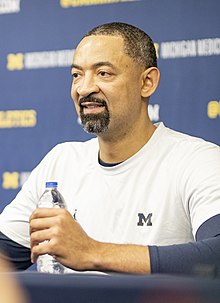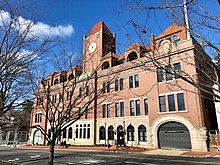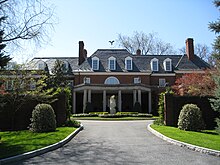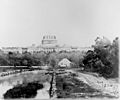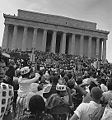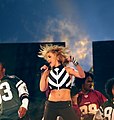Portal:Washington, D.C.
Portal maintenance status: (No date set)
|
The Washington, D.C. portal

Washington, D.C., formally the District of Columbia and commonly known as Washington or D.C., is the capital city and federal district of the United States. The city is on the Potomac River, across from Virginia, and shares land borders with Maryland to its north and east. It was named after George Washington, the first president of the United States. The district is named after Columbia, the female personification of the nation.
The U.S. Constitution in 1789 called for the creation of a federal district under the exclusive jurisdiction of the U.S. Congress. As such, Washington, D.C., is not part of any state, and is not one itself. The Residence Act, adopted on July 16, 1790, approved the creation of the capital district along the Potomac River. The city was founded in 1791, and the 6th Congress held the first session in the unfinished Capitol Building in 1800 after the capital moved from Philadelphia. In 1801, the District of Columbia, formerly part of Maryland and Virginia and including the existing settlements of Georgetown and Alexandria, was officially recognized as the federal district; initially, the city was a separate settlement within the larger district. In 1846, Congress returned the land originally ceded by Virginia, including the city of Alexandria. In 1871, it created a single municipality for the remaining portion of the district. There have been several unsuccessful efforts to make the district into a state since the 1880s; a statehood bill passed the House of Representatives in 2021 but was not adopted by the U.S. Senate.
Washington, D.C. anchors the southern end of the Northeast megalopolis. As the seat of the U.S. federal government, the city is an important world political capital. The city hosts the buildings that house federal government headquarters, including the White House, the Capitol, the Supreme Court Building, and multiple federal departments and agencies. The city is home to many national monuments and museums, located most prominently on or around the National Mall, including the Jefferson Memorial, the Lincoln Memorial, and the Washington Monument. It hosts 177 foreign embassies and serves as the headquarters for the World Bank, the International Monetary Fund, the Organization of American States, and other international organizations. Home to many of the nation's largest industry associations, non-profit organizations, and think tanks, D.C. is known as a lobbying hub, with K Street as the industry center. The city had 20.7 million domestic visitors and 1.2 million international visitors, ranking seventh among U.S. cities as of 2022. (Full article...)
-
Image 1
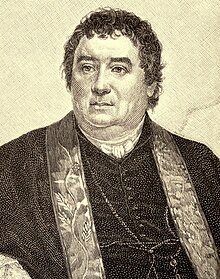
Benedict Joseph Fenwick SJ (September 3, 1782 – August 11, 1846) was an American Catholic prelate, Jesuit, and educator who served as the Bishop of Boston from 1825 until his death in 1846. In 1843, he founded the College of the Holy Cross in Worcester, Massachusetts. Prior to that, he was twice the president of Georgetown College and established several educational institutions in New York City and Boston. (Full article...) -
Image 2

Giovanni Antonio Grassi SJ (anglicized as John Anthony Grassi; 10 September 1775 – 12 December 1849) was an Italian Catholic priest and Jesuit who led many academic and religious institutions in Europe and the United States, including Georgetown College in Washington, D.C., and the Pontificio Collegio Urbano de Propaganda Fide in Rome. (Full article...) -
Image 3
Bernard A. Maguire SJ (February 11, 1818 – April 26, 1886) was an Irish-American Catholic priest and Jesuit who served twice as the president of Georgetown University. Born in Ireland, he emigrated to the United States at the age of six, and his family settled in Maryland. Maguire attended Saint John's College in Frederick, Maryland, and then entered the Society of Jesus in 1837. He continued his studies at Georgetown University, where he also taught and was prefect, until his ordination to the priesthood in 1851. (Full article...) -
Image 4
Patrick Francis Healy SJ (February 27, 1834 – January 10, 1910) was an American Catholic priest and Jesuit who was an influential president of Georgetown University, becoming known as its "second founder". The university's flagship building, Healy Hall, bears his name. Though he considered himself and was widely accepted as White, Healy was posthumously recognized as the first Black American to earn a PhD, as well as the first to enter the Jesuit order and to become the president of a predominantly White university. (Full article...) -
Image 5

William McSherry SJ (July 19, 1799 – December 18, 1839) was an American Catholic priest and Jesuit who became the president of Georgetown College and a Jesuit provincial superior. The son of Irish immigrants, McSherry was educated at Georgetown College, where he entered the Society of Jesus. As one of the first Americans to complete the traditional Jesuit course of training, he was sent to Rome to be educated for the priesthood. There, he made several discoveries of significant, forgotten holdings in the Jesuit archives, which improved historians' knowledge of the early European settling of Maryland and of the language of Indian tribes there. (Full article...) -
Image 6

Samuel A. Mulledy SJ (/mʌˈleɪdi/ muh-LAY-dee; March 27, 1811 – January 8, 1866) was an American Catholic priest and Jesuit who served as president of Georgetown College in 1845. Born in Virginia, he was the brother of Thomas F. Mulledy, who was a prominent 19th-century Jesuit in the United States and a president of Georgetown. As a student at Georgetown, Samuel was one of the founding members of the Philodemic Society, and proved to be a distinguished student, which resulted in his being sent to Rome to complete his higher education and be ordained to the priesthood. Upon his return to the United States, he became the master of novices at the Jesuit novitiate in Maryland, before being named president of Georgetown. He sought to be relieved of the position after only a few months, and returned to teaching and ministry. (Full article...) -
Image 7
Joseph Havens Richards SJ (born Havens Cowles Richards; November 8, 1851 – June 9, 1923) was an American Catholic priest and Jesuit who became a prominent president of Georgetown University, where he instituted major reforms and significantly enhanced the quality and stature of the university. Richards was born to a prominent Ohio family; his father was an Episcopal priest who controversially converted to Catholicism and had the infant Richards secretly baptized as a Catholic. (Full article...) -
Image 8
James Abram Garfield (November 19, 1831 – September 19, 1881) was the 20th president of the United States, serving from March 1881 until his assassination in September that year. A preacher, lawyer, and Civil War general, Garfield served nine terms in the United States House of Representatives and is the only sitting member of the House to be elected president. Before his candidacy for the presidency, he had been elected to the U.S. Senate by the Ohio General Assembly—a position he declined when he became president-elect. (Full article...) -
Image 9
Harmon Clayton Killebrew Jr. (/ˈkɪlɪbruː/; June 29, 1936 – May 17, 2011), nicknamed "the Killer" and "Hammerin' Harmon", was an American professional baseball first baseman, third baseman, and left fielder. He spent most of his 22-year career in Major League Baseball (MLB) with the Minnesota Twins. A prolific power hitter, Killebrew had the fifth-most home runs in major league history at the time of his retirement. He was second only to Babe Ruth in American League (AL) home runs, and was the AL career leader in home runs by a right-handed batter. Killebrew was inducted into the National Baseball Hall of Fame in 1984. (Full article...) -
Image 10
Otto Everett Graham Jr. (December 6, 1921 – December 17, 2003) was an American professional football quarterback who played for the Cleveland Browns in the All-America Football Conference (AAFC) and National Football League (NFL) for 10 seasons. Graham is regarded by critics as one of the most dominant players of his era and one of the greatest quarterbacks of all time, having taken the Browns to league championship games every year between 1946 and 1955, making ten championship appearances, and winning seven of them. With Graham at quarterback, the Browns posted a record of 105 wins, 17 losses, and 4 ties, including a 9–3 win–loss record in the AAFC and NFL playoffs. He holds the NFL record for career average yards gained per pass attempt, with 8.63. He also holds the record for the highest career winning percentage for an NFL starting quarterback, at 81.0%. Long-time New York Yankees owner George Steinbrenner, a friend of Graham's, once called him "as great of a quarterback as there ever was." (Full article...) -
Image 11

Joseph Anton Lopez SJ (born José Antonio López; October 4, 1779 – October 5, 1841) was a Mexican Catholic priest and Jesuit. Born in Michoacán, he studied canon law at the Colegio de San Nicolás and the Royal and Pontifical University of Mexico. He became acquainted with the future Empress consort Ana María Huarte and was made chaplain to the future imperial family. He was later put in charge of the education of all the princes in Mexico. Lopez was a close ally of Emperor Agustín de Iturbide, residing in Madrid for four years as his attorney and political informant, and accompanying him during his exile to Italy and England. (Full article...) -
Image 12

Stephen Colbert and his wife Evelyn McGee at the Time 100 most influential people awards for 2006
On April 29, 2006, American comedian Stephen Colbert appeared as the featured entertainer at the 2006 White House Correspondents' Association Dinner, which was held in Washington, D.C., at the Hilton Washington hotel. Colbert's performance, consisting of a 16-minute podium speech and a 7-minute video presentation, was broadcast live across the United States on the cable television networks C-SPAN and MSNBC. Standing a few feet from U.S. President George W. Bush, in front of an audience of celebrities, politicians, and members of the White House Press Corps, Colbert delivered a controversial, searing routine targeting the president and the media. He spoke in the persona of the character he played on Comedy Central's The Colbert Report, a parody of conservative pundits such as Bill O'Reilly and Sean Hannity. (Full article...) -
Image 13Enoch Fenwick SJ (May 15, 1780 – November 25, 1827) was an American Catholic priest and Jesuit who ministered throughout Maryland and became the twelfth president of Georgetown College. Descending from one of the original Catholic settlers of the Province of Maryland, he studied at Georgetown College in what is now Washington, D.C. Like his brother and future bishop, Benedict Joseph Fenwick, he entered the priesthood, studying at St. Mary's Seminary before entering the Society of Jesus, which was suppressed at the time. He was made rector of St. Peter's Pro-Cathedral in Baltimore by Archbishop John Carroll, and remained in the position for ten years. Near the end of his pastorate, he was also made vicar general of the Archdiocese of Baltimore, which involved traveling to say Mass in remote parishes throughout rural Maryland. (Full article...)
-
Image 14Howard as head coach of Michigan in 2020
Juwan Antonio Howard (first name /dʒuː.ˈwɑːn/, born February 7, 1973) is an American professional basketball coach and former player who is an assistant coach for the Brooklyn Nets of the National Basketball Association (NBA). He previously served as the head coach of the Michigan Wolverines men's team from 2019 to 2024 before joining the Nets in 2024. (Full article...) -
Image 15Look Mickey (also known as Look Mickey!) is a 1961 oil on canvas painting by Roy Lichtenstein. Widely regarded as the bridge between his abstract expressionism and pop art works, it is notable for its ironic humor and aesthetic value as well as being the first example of the artist's employment of Ben-Day dots, speech balloons and comic imagery as a source for a painting. The painting was bequeathed to the Washington, D.C., National Gallery of Art upon Lichtenstein's death. (Full article...)
-
Image 16M Street elevation in December 2018
The Georgetown Car Barn, historically known as the Capital Traction Company Union Station, is a building in the Georgetown neighborhood of Washington, D.C., in the United States. Designed by the architect Waddy Butler Wood, it was built between 1895 and 1897 by the Capital Traction Company as a union terminal for several Washington and Virginia streetcar lines. The adjacent Exorcist steps, later named after their appearance in William Friedkin's 1973 horror film The Exorcist, were built during the initial construction to connect M Street with Prospect Street. (Full article...) -
Image 17
David Hillhouse Buel Jr. (July 19, 1862 – May 23, 1923) was an American priest who served as the president of Georgetown University. A Catholic priest and Jesuit for much of his life, he later left the Jesuit order to marry, and subsequently left the Catholic Church to become an Episcopal priest. Born at Watervliet, New York, he was the son of David Hillhouse Buel, a distinguished Union Army officer, and descended from numerous prominent New England families. While studying at Yale University, he formed an acquaintance with priest Michael J. McGivney, resulting in his conversion to Catholicism and joining the Society of Jesus after graduation. (Full article...) -
Image 18

John William Beschter SJ (born Johann Wilhelm Beschter; German: [ˈjoːhan ˈvɪlhɛlm ˈbɛʃtɐ]; [needs Luxembourgish IPA] May 20, 1763 – January 6, 1842) was a Catholic priest and Jesuit from the Duchy of Luxembourg in the Austrian Netherlands. He emigrated to the United States as a missionary in 1807, where he ministered in rural Pennsylvania and Maryland. Beschter was the last Jesuit pastor of St. Mary's Church in Lancaster, as well as the pastor of St. John the Evangelist Church in Baltimore, Maryland. He was also a priest at several other German-speaking churches in Pennsylvania. (Full article...) -
Image 19
John Dunning Whitney SJ (July 19, 1850 – November 27, 1917) was an American Catholic priest and Jesuit who became the president of Georgetown University in 1898. Born in Massachusetts, he joined the United States Navy at the age of 16, where he was introduced to Catholicism by way of a book that accidentally came into his possession and prompted him to become a Catholic. He entered the Society of Jesus and spent the next twenty-five years studying and teaching mathematics at Jesuit institutions around the world, including in Canada, England, Ireland, and around the United States in New York, Maryland, Boston, and Louisiana. He became the vice president of Spring Hill College in Alabama before being appointed the president of Georgetown University. (Full article...) -
Image 20

Charles Henry Stonestreet SJ (November 21, 1813 – July 3, 1885) was an American Catholic priest and Jesuit who served in prominent religious and academic positions, including as provincial superior of the Jesuit Maryland Province and president of Georgetown University. He was born in Maryland and attended Georgetown University, where he co-founded the Philodemic Society. After entering the Society of Jesus and becoming a professor at Georgetown, he led St. John's Literary Institution and St. John the Evangelist Church in Frederick, Maryland. He was appointed president of Georgetown University in 1851, holding the office for two years, during which time he oversaw expansion of the university's library. The First Plenary Council of Baltimore was held at Georgetown during his tenure. (Full article...) -
Image 21
Andrew Jackson (March 15, 1767 – June 8, 1845) was the seventh president of the United States, serving from 1829 to 1837. Before his presidency, he gained fame as a general in the U.S. Army and served in both houses of the U.S. Congress. Often praised as an advocate for ordinary Americans and for his work in preserving the union of states, Jackson has also been criticized for his racial policies, particularly his treatment of Native Americans. (Full article...) -
Image 22
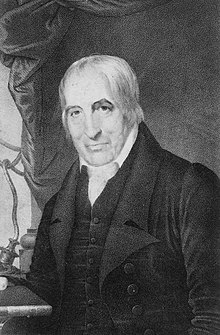
Francis Ignatius Neale SJ (June 3, 1756 – December 20, 1837), also known as Francis Xavier Neale, was an American Catholic priest and Jesuit who led several academic and religious institutions in Washington, D.C., and Maryland. He played a substantial role in the Jesuit order's resurgence in the United States. (Full article...) -
Image 23

Nativity, c. mid-1450s. Oil on wood, 127.6 cm × 94.9 cm (50.2 in × 37.4 in), National Gallery of Art, Washington, D.C.
The Nativity is a devotional mid-1450s oil-on-wood panel painting by the Early Netherlandish painter Petrus Christus. It shows a nativity scene with grisaille archways and trompe-l'œil sculptured reliefs. Christus was influenced by the first generation of Netherlandish artists, especially Jan van Eyck and Rogier van der Weyden, and the panel is characteristic of the simplicity and naturalism of art of that period. Placing archways as a framing device is a typical van der Weyden device, and here likely borrowed from that artist's Saint John Altarpiece and Miraflores Altarpiece. Yet Christus adapts these painterly motifs to a uniquely mid-15th century sensibility, and the unusually large panel – perhaps painted as a central altarpiece panel for a triptych – is nuanced and visually complex. It shows his usual harmonious composition and employment of one-point-perspective, especially evident in the geometric forms of the shed's roof, and his bold use of color. It is one of Christus's most important works. Max Friedländer definitely attributed the panel to Christus in 1930, concluding that "in scope and importance, [it] is superior to all other known creations of this master." (Full article...) -
Image 24
James Madison (March 16, 1751 – June 28, 1836) was an American statesman, diplomat, and Founding Father who served as the fourth president of the United States from 1809 to 1817. Madison was popularly acclaimed the "Father of the Constitution" for his pivotal role in drafting and promoting the Constitution of the United States and the Bill of Rights. (Full article...) -
Image 25
James Aloysius Doonan SJ (November 8, 1841 – April 12, 1911) was an American Catholic priest and Jesuit, who was the president of Georgetown University from 1882 to 1888. During that time he oversaw the naming of Gaston Hall and the construction of a new building for the School of Medicine. Doonan also acquired two historic cannons that were placed in front of Healy Hall. His presidency was financially successful, with a reduction in the university's burdensome debt that had accrued during the construction of Healy Hall. (Full article...)
Neighboorhoods
-
Image 1
Fairlawn is a working class and middle class residential neighborhood in southeast Washington, D.C., United States. It is bounded by Interstate 295, Pennsylvania Avenue SE, Minnesota Avenue SE (between Pennsylvania Avenue SE and Naylor Road SE), Naylor Road SE (between Minnesota Avenue SE Good Hope Road SE), and Good Hope Road SE. (Full article...) -
Image 2
Arboretum is a predominantly residential neighborhood located in Northeast Washington, D.C., tucked into the corner of the National Arboretum. (Full article...) -
Image 3
-
Image 4
Deanwood is a neighborhood in Northeast Washington, D.C., bounded by Eastern Avenue to the northeast, Kenilworth Avenue to the northwest, Division Avenue to the southeast, and Nannie Helen Burroughs Avenue to the south. (Full article...) -
Image 5
Fort Stanton was a Civil War-era fortification constructed in the hills above Anacostia in the District of Columbia, USA, and was intended to prevent Confederate artillery from threatening the Washington Navy Yard. It also guarded the approach to the bridge that connected Anacostia (then known as Uniontown) with Washington. Built in 1861, the fort was expanded throughout the war and was joined by two subsidiary forts: Fort Ricketts and Fort Snyder. Following the surrender of the Army of Northern Virginia, it was dismantled and the land returned to its original owner. It never saw combat. Abandoned after the war, the site of the fort was planned to be part of a grand "Fort Circle" park system encircling the city of Washington. Though this system of interconnected parks never was fully implemented, the site of the fort is today a park maintained by the National Park Service, and a historical marker stands near the fort's original location. (Full article...) -
Image 6

Intersection of Blaine St. and Burns St. NE, in East River Heights, May 2019
East River Heights is a residential and mixed use neighborhood located in Ward 7 of Washington, DC. It is considered the "downtown" area of the ward and has high walkability ratings. Its borders are East Capital Street, Minnesota Ave, Benning Road up to 41st Street. It is a neighborhood of retired and working people and many children. There is quite a bit of development occurring. The houses are small but have large yards. It is centrally located.
It is located between the Minnesota Avenue and Benning Road stations on the Washington Metro. (Full article...) -
Image 7
Benning is a residential neighborhood located in Ward 7 of Northeast Washington, D.C. It is bounded by East Capitol Street to the south, Minnesota Avenue to the west, and Benning Road (for which the neighborhood is named) on the north and east. It is served by the Benning Road station on the Blue and Silver Lines of the Washington Metro. (Full article...) -
Image 8Brookland in 2022 with the Brookland–CUA station Metro station in the foreground
Brookland, also known as Little Rome or Little Vatican, is a neighborhood located in the Northeast (NE) quadrant of Washington, D.C. Bounded by Fort Totten Metro Train tracks NE, and Brookland CUA Metro train tracks, Taylor Street NE, Rhode Island Avenue NE, South Dakota Avenue NE.It is best known for its numerous Catholic institutions, including schools, religious communities, shrines, institutes, and other organizations built and based around the Catholic University of America. (Full article...) -
Image 9

Shaw is a neighborhood of Washington, D.C., located in the Northwest quadrant. Shaw is a major entertainment and retail hub, and much of the neighborhood is designated as a historic district, including the smaller Blagden Alley-Naylor Court Historic District. Shaw and the U Street Corridor have historically have been the city's hub for African-American social, cultural, and economic life. (Full article...) -
Image 10Map of Washington, D.C., with Kent highlighted in red
Kent is a neighborhood in Northwest Washington, D.C. in the United States, bounded by Loughboro Road to the north, MacArthur Boulevard to the southwest, and Chain Bridge Road and Battery Kemble Park to the southeast. It is a suburban neighborhood, home to some of the most expensive homes in the city with an average home sales price in 2012 of $1.7 million ($2.26 million today). (Full article...) -
Image 11

Map of Washington, D.C., with Hawthorne highlighted in red
Hawthorne is a neighborhood of 308 single family homes in the Northwest quadrant of Washington, D.C. According to neighborhood lore, the subdivision was named for the hawthorn trees once abundant in the area. The neighborhood borders Montgomery County, Maryland, and is bounded by Pinehurst Parkway Park NW, Western Avenue NW, and Oregon Avenue NW, (Full article...) -
Image 12
The Palisades, or simply Palisades, is a neighborhood in Washington, D.C., along the Potomac River, running roughly from the edge of the Georgetown University campus (at Foxhall Road) to the D.C.-Maryland boundary (near Dalecarlia Treatment Plant). (Full article...) -
Image 13
Forest Hills is a residential neighborhood in the northwest quadrant of Washington, D.C., United States, bounded by Connecticut Avenue NW to the west, Rock Creek Park to the east, Chevy Chase to the north, and Tilden Street NW to the south. The neighborhood is frequently referred to as Van Ness because it is served by the Van Ness–UDC station on the Washington Metro's Red Line and is near the Van Ness campus of the University of the District of Columbia (UDC). (Full article...) -
Image 14
Skyland is a neighborhood in Southeast Washington, D.C. It is bounded by Good Hope Road to the northeast, Alabama Avenue to the southeast, and Fort Stanton Park to the south and west. It is part of Ward 8. Also see article on the Anacostia neighborhood. (Full article...) -
Image 15
Langdon, is a neighborhood located in Ward 5 of Northeast Washington, D.C. Historical surveys of D.C. recognize Langdon as a neighborhood dating back to at least 1903. Langdon is bounded by Montana Ave. NE to the west/southwest, New York Ave. NE to the south, Bladensburg Rd. NE to the southeast, South Dakota Ave. NE to the northeast, and Rhode Island Ave. NE to the north/northwest. Langdon is adjacent to the Northeast D.C. neighborhoods of Brentwood (west), Woodridge (east), Fort Lincoln (southeast), Gateway (south), and Brookland (north). (Full article...) -
Image 16

Shaw is a neighborhood of Washington, D.C., located in the Northwest quadrant. Shaw is a major entertainment and retail hub, and much of the neighborhood is designated as a historic district, including the smaller Blagden Alley-Naylor Court Historic District. Shaw and the U Street Corridor have historically have been the city's hub for African-American social, cultural, and economic life. (Full article...) -
Image 17
Capitol View is a neighborhood located in southeast Washington, D.C., in the United States. It is bounded by East Capitol Street to the north, Central Avenue SE to the southwest and south, and Southern Avenue SE to the southeast. (Full article...)
Selected image
-
Image 2The John A. Wilson Building is the headquarters for much of the Government of the District of Columbia, including the offices of the mayor and D.C. Council. (from Washington, D.C.)
-
Image 3The U.S. Capitol dome was under construction during Lincoln's first inauguration on March 4, 1861, five weeks before the start of the American Civil War. (from Washington, D.C.)
-
Image 4Metrobus, operated by the Washington Metropolitan Area Transit Authority (from Washington, D.C.)
-
Image 6The Washington Monument stood in this unfinished form for 25 years before being completed in 1884. (from History of Washington, D.C.)
-
Image 7Axis undergoing restoration (October 2015) (from National Mall)
-
Image 8President Abraham Lincoln insisted that construction of the United States Capitol continue during the Civil War. (from History of Washington, D.C.)
-
Image 9Axis after restoration (September 2016) (from National Mall)
-
Image 12The Smithsonian Museum of Natural History was the most visited museum in the U.S. in 2022, with 3.9 million visits. (from Washington, D.C.)
-
Image 13The United States Capitol in 1846, prior to the addition of the current rotunda (from History of Washington, D.C.)
-
Image 15The National Gallery of Art was the most visited art museum in the United States in 2022. (from Washington, D.C.)
-
Image 16The Washington Capitals, an NHL team, and the Washington Wizards, an NBA team, both play at Capital One Arena. (from Washington, D.C.)
-
Image 17The Jefferson Memorial and many of D.C.'s other monuments are built in the Neoclassical style. (from Washington, D.C.)
-
Image 18Ben's Chili Bowl, known for its half-smoke, a historic staple of the city's cuisine (from Washington, D.C.)
-
Image 20The Concert for Valor on the National Mall on November 11, 2014, looking west from the U.S. Capitol grounds (from National Mall)
-
Image 21On September 18, 1783, an engraving of George Washington, known as the First Cornerstone, was placed as the corner stone of the United States Capitol. (from History of Washington, D.C.)
-
Image 24Eisenhower Memorial at night, 2021 (from National Mall)
-
Image 25Territorial progression of Washington, D.C. (from History of Washington, D.C.)
-
Image 26Civil rights marchers during the March on Washington at the Lincoln Memorial on August 28, 1963 (from History of Washington, D.C.)
-
Image 27A panel discussion at the American Enterprise Institute, one of D.C.'s many think tanks (from Washington, D.C.)
-
Image 29Facing east on the National Mall, as viewed near the 1300 block of Jefferson Drive, S.W. in April 2010. Rows of American elm trees line the sides of a path traversing the length of the Mall. (from National Mall)
-
Image 30The first inauguration of Barack Obama on January 20, 2009, facing west from the Capitol (from National Mall)
-
Image 31Washington Metro, the second-busiest rapid rail system in the U.S. based on average weekday ridership, is known for its iconic vaulted ceilings (from Washington, D.C.)
-
Image 33Looking east from the top of the Washington Monument towards the Mall and the U.S. Capitol, 2023 (from National Mall)
-
Image 34The Aqueduct Bridge crossing the Potomac River, with Northern Virginia in the background and the Chesapeake and Ohio Canal in the foreground (from History of Washington, D.C.)
-
Image 35Georgetown University, founded in 1789, is the city's oldest university. (from Washington, D.C.)
-
Image 36The Blue Plains Advanced Wastewater Treatment Plant in D.C. is the largest advanced wastewater treatment facility in the world. (from Washington, D.C.)
-
Image 38Reading Room at the Library fo Congress (from National Mall)
-
Image 39The city's African American population has declined since the 1968 riots. (from Washington, D.C.)
-
Image 40Demonstrators marching down Pennsylvania Avenue towards the United States Capitol on January 6, 2021 (from History of Washington, D.C.)
-
Image 41The southern portion of the National Mall in 1863 during the American Civil War (from History of Washington, D.C.)
-
Image 431963 March on Washington for Jobs and Freedom on the National Mall facing east from the Lincoln Memorial (from National Mall)
-
Image 45The Washington Monument viewed from the Tidal Basin during the National Cherry Blossom Festival in April 2018 (from Washington, D.C.)
-
Image 47An 1814 watercolor illustration of the United States Capitol after the burning of Washington during the War of 1812 (from History of Washington, D.C.)
-
Image 48One Franklin Square, located in Downtown, hosts the headquarters of The Washington Post. (from Washington, D.C.)
-
Image 49Map of the Mall in 1893 showing the Monument Grounds (with the Washington Monument), Agricultural Grounds (with the Dept. of Agriculture), Smithsonian Grounds (with the Castle and Arts and Industries museum), Armory Square, Public Grounds and Botanical Garden, as well as parts of the recently created "Tidal Reservoir" and "Proposed Park" (from National Mall)
-
Image 50Due to limited dining options on the Mall, food trucks are often parked next to tourist-dense locations. (from National Mall)
-
Image 51The city's license plate calls for an end to taxation without representation. (from Washington, D.C.)
-
Image 52Eastward view of the National Mall from the top of the Washington Monument in 1918. The three structures and two chimneys crossing the Mall are temporary World War I buildings A, B and C and parts of their central power plant. (from National Mall)
-
Image 54The Mall following a snow storm (from National Mall)
-
Image 55National Mall proper and adjacent areas (April 2002). The Mall had a grassy lawn flanked on each side by unpaved paths and rows of American elm trees as its central feature. (Numbers in the image correspond to numbers in the list of landmarks, museums and other features below.) (from National Mall)
-
Image 56The Federal Triangle, a historic hub of executive departments of the U.S. federal government (from Washington, D.C.)
-
Image 57Britney Spears performs during the "NFL Kickoff Live from the National Mall Presented by Pepsi Vanilla" concert, September 4, 2003 (from National Mall)
-
Image 59US Capitol in the 2010 blizzard (from Washington, D.C.)
-
Image 60After their victory at the Battle of Bladensburg in 1814, the British Army burned the White House and other buildings during a one-day occupation of Washington, D.C. (from Washington, D.C.)
-
Image 61Map of racial distribution in the Washington metropolitan area, according to the 2010 U.S. census; each dot represents 25 people: White, Black, Asian, Hispanic or Other (yellow) (from Washington, D.C.)
-
Image 63Rock Creek Park, the city's largest park, stretches across Northwest. (from Washington, D.C.)
-
Image 64Westward view from the top of the Washington Monument in 1943 or 1944 during World War II. In the foreground, temporary buildings on the Washington Monument grounds house the Navy's Bureau of Ships. The Main Navy and Munitions Buildings stand to the right of the Lincoln Memorial Reflecting Pool. Temporary buildings to the left of the Reflecting Pool house the Navy's Bureau of Supplies and Accounts. (from National Mall)
-
Image 65Yetsom beyaynetu at Das Ethiopian Cuisine, one of D.C.'s many Ethiopian restaurants (from Washington, D.C.)
-
Image 66The National World War II Memorial is among the many popular tourist sites located on the National Mall. (from Washington, D.C.)
-
Image 67Pool after reconstruction (May 2016) (from National Mall)
-
Image 68The April 9, 1939, concert by Marian Anderson, facing east from the Lincoln Memorial (from National Mall)
-
Image 69The Vietnam Veterans Memorial, designed by Maya Lin, was initially controversial for its lack of heroic iconography, a departure from earlier memorial designs. (from Washington, D.C.)
-
Image 70The Northeast Boundary No. 4 marker stone of the original border between the District of Columbia and Prince George's County, Maryland (from History of Washington, D.C.)
-
Image 71With over 30,000 participants, the annual Marine Corps Marathon, held annually in October, is the largest non-prize money marathon in the country. (from Washington, D.C.)
-
Image 73Duke Ellington School of the Arts, a public magnet school in the city (from Washington, D.C.)
-
Image 74Library of Congress(from National Mall)
The "Grand Avenue" or Mall as proposed by Pierre L'Enfant, 1791 -
Image 75National Mall, a landscaped park extending from the Lincoln Memorial to the United States Capitol (from Washington, D.C.)
-
Image 762009 view from the United States Capitol facing west, over the Grant Memorial and Capitol Reflecting Pool in the foreground, and across the National Mall towards the Washington Monument (from National Mall)
-
Image 77Construction of the Washington Metro on Connecticut Avenue in 1973 (from History of Washington, D.C.)
-
Image 82Rows of young American elm trees on the National Mall, looking east from the top of the Washington Monument, circa 1942 (from National Mall)
-
Image 83A performance of Moulin Rouge! at the Kennedy Center for the Performing Arts (from Washington, D.C.)
-
Image 84The Pentagon following the September 11 attacks with the Washington Monument visible in the background (from History of Washington, D.C.)
-
Image 85The Chesapeake and Ohio Canal was extended to Georgetown in 1830. (from Washington, D.C.)
-
Image 86This view from the top of the Washington Monument shows rows of elm trees lining the Reflecting Pool (November 2014). (from National Mall)
-
Image 90Map of the District of Columbia in 1835, prior to the retrocession (from History of Washington, D.C.)
-
Image 91The Eisenhower Executive Office Building, built between 1871 and 1888, was the world's largest office building until 1943, when it was surpassed by The Pentagon. (from Washington, D.C.)
-
Image 94Memorial Bridge connects the city across the Potomac River with Arlington, Virginia. (from Washington, D.C.)
-
Image 98General Dwight D. Eisenhower received a hero's welcome in the city in June 1945 following the Allied victory in World War II (from History of Washington, D.C.)
-
Image 100The National Mall was the centerpiece of the 1902 McMillan Plan. A central open vista traversed the length of the Mall. (from National Mall)
-
Image 101Washington, D.C., police on Harley-Davidson motorcycles escort the March for Life protest on Constitution Avenue in January 2018. (from Washington, D.C.)
-
Image 102City of Washington from Beyond the Navy Yard, an 1833 portrait by George Cooke in the Oval Office in the White House (from History of Washington, D.C.)
-
Image 103The March on Washington at the Lincoln Memorial Reflecting Pool on August 28, 1963 (from Washington, D.C.)
-
Image 104John F. Kennedy Center for the Performing Arts (from National Mall)
-
Image 106The Library of Congress, the world's largest library with more than 167 million cataloged items and the nation's oldest cultural institution (from Washington, D.C.)
-
Image 107West side of the U.S. Capitol building (March 2019) (from National Mall)
-
Image 108Lincoln Memorial Reflecting Pool before reconstruction (April 2010) (from National Mall)
-
Image 109The United States Congress began assembling in the new United States Capitol in 1800 after the nation's capital was moved from Philadelphia. (from Washington, D.C.)
-
Image 110Reagan Washington National Airport in Arlington, Virginia is the closest airport to the city among the three major Washington metropolitan area airports. (from Washington, D.C.)
-
Image 111Portrait of the Mall and vicinity looking northwest from southeast of the U.S. Capitol, circa 1846–1855, showing stables in the foreground, the Washington City Canal behind them, the Capitol on the right and the Smithsonian "Castle", the Washington Monument and the Potomac River in the distant left. (from National Mall)
-
Image 112The National Mall, including a central pathway through it, the centerpiece of the 1901 McMillan Plan (from History of Washington, D.C.)
-
Image 113A major bus strike in May 1974 caused huge traffic jams throughout the city (from History of Washington, D.C.)
Did you know...
- ... that after Michael Jordan was fired by the Washington Wizards, he wanted to move the Capital Classic from the Washington, D.C., area to New York?
- ... that in one neighborhood commission district, the voters and officeholders are all inmates at the D.C. Jail?
- ... that prior to attorney Stanley Woodward representing Donald Trump aide Walt Nauta and Oath Keeper Kelly Meggs, he represented tenants in D.C. who were facing eviction?
- ... that a coconut tree meme drove sales of piña coladas in the Washington, D.C., area?
- ... that Ron Brown, the United States secretary of commerce, leased equipment to a TV station in Washington, D.C., whose owner turned out to be his lover?
- ... that Roland Jefferson, the first African-American botanist to work at the U.S. National Arboretum, helped preserve the famous flowering cherry trees in Washington, D.C.?
In the news
- 6 November 2024 – 2024 U.S. elections
- U.S. Vice President and Democratic Party candidate Kamala Harris concedes defeat to Donald Trump in a speech at Howard University in Washington, D.C., stating that she and U.S. President Joe Biden will commit to a peaceful transition of power. (Time)
- 17 September 2024 – Ituri conflict
- CODECO militants kill ten civilians in an overnight attack on a Hema village in Ituri Province, Democratic Republic of the Congo. Some of the victims were beheaded, according to local authorities. (Reuters)
Categories
- Select [►] to view subcategories
Topics
| Topics | |
|---|---|
| Government | |
| Services | |
| Society | |
| History |
|
Related portals
Related WikiProjects
Associated Wikimedia
The following Wikimedia Foundation sister projects provide more on this subject:
-
Commons
Free media repository -
Wikibooks
Free textbooks and manuals -
Wikidata
Free knowledge base -
Wikinews
Free-content news -
Wikiquote
Collection of quotations -
Wikisource
Free-content library -
Wikispecies
Directory of species -
Wikiversity
Free learning tools -
Wikivoyage
Free travel guide -
Wiktionary
Dictionary and thesaurus
- Pages using Template:Post-nominals with customized linking
- Pages with German IPA
- Portals with undated maintenance templates
- Automatically maintained portals with listed maintainers
- Portals with untriaged subpages
- All portals with untriaged subpages
- Portals with named maintainer
- Automated article-slideshow portals with less than 2 articles in article list














